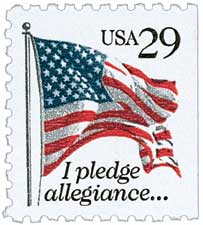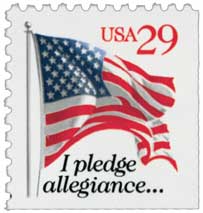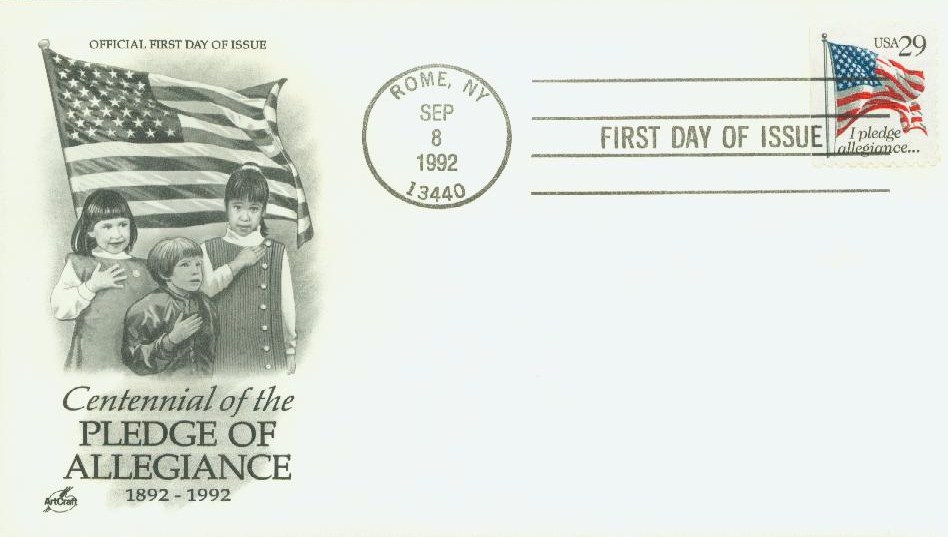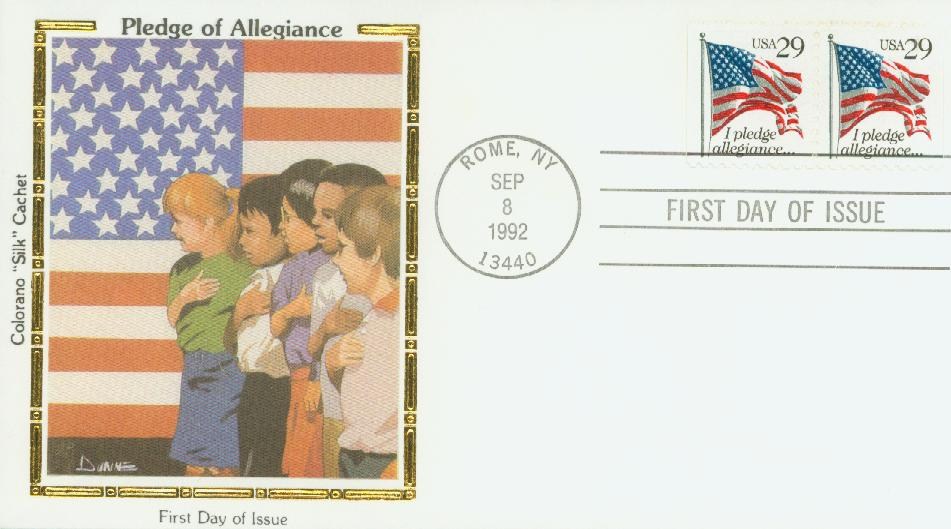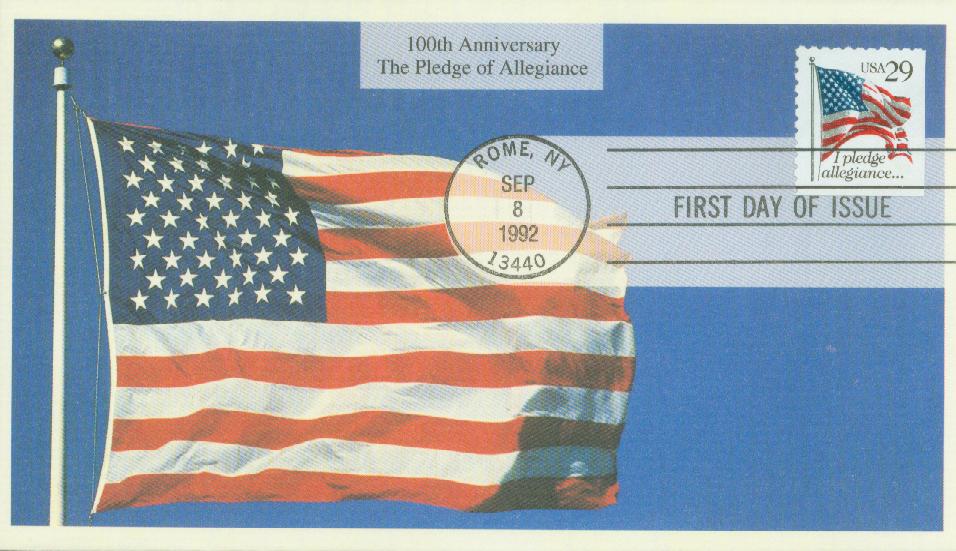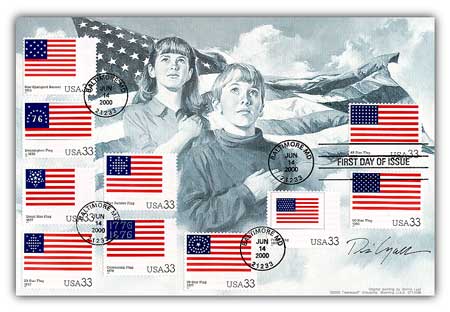
# 571153B - 2000 Pledge of Allegiance Presentation Card
Often called the ultimate philatelic issue, the Fleetwood Proofcard is a distinctive commemorative with an elegantly embossed surface. Each Proofcard bears an original work of art complementing the theme of the stamp and created exclusively for Fleetwood by a leading American artist. Proofcards are often collected on their own, but would also make a beautiful addition to your existing stamp or cover collection.
Pledge Of Allegiance
On June 22, 1942, Congress formally adopted the Pledge of Allegiance.
Francis Bellamy wrote the pledge. Bellamy was born in 1855 and raised in Rome, New York, where his father, David, was the pastor of the First Baptist Church.
In 1884, Bellamy accepted a position with the Dearborn Street Church in Boston. While in Boston, Bellamy was part of a national committee that formed to foster patriotism in schools in conjunction with the 400th anniversary of Columbus’ discovery of America. James Upham of The Youth’s Companion magazine saw the event as an opportunity to support his goal of placing flags in every school in America.
Bellamy was tasked with writing a brief salute to be recited as the flag was raised. Though the result was just 23 words, Bellamy labored over every one of them, ensuring the final pledge would be both concise and meaningful. He penned the pledge on September 7, and it was published the following day:
“I pledge allegiance to my Flag and to the Republic for which it stands; one Nation, indivisible, with Liberty and Justice for all.”
A month later, the pledge was recited for the first time by over 12 million school children on Columbus Day. The pledge soon became a daily exercise at most American schools. It was over 30 years before adults began using the words to affirm their patriotism. The 1923 National Flag Conference made it popular with adults. After that, the pledge became commonplace in meetings and events throughout the country.
On June 22, 1942, Congress formally adopted the pledge as part of the US Flag Code. And in 1945, the official name, “Pledge of Allegiance,” was adopted.
Though its ideals are still the same, the wording has changed over the years. In 1923, the phrase “the flag of the United States of America” replaced “my Flag,” to distinguish it from the flags of other nations. The words “under God” were added in 1954, taken from Lincoln’s Gettysburg Address, but have come under attack as the battle over religion continues.
Perhaps the most unusual change came not in the wording, however, but in the salute that Bellamy devised to be used during the pledge. In 1942, this straight-arm salute was dropped when the Nazi Party in Germany began using it and changed to placing a hand over the heart. The pledge, as it has remained since 1954, is “I pledge allegiance to the Flag of the United States of America, and to the Republic for which it stands: one Nation under God, indivisible, with Liberty and Justice for all.”
Often called the ultimate philatelic issue, the Fleetwood Proofcard is a distinctive commemorative with an elegantly embossed surface. Each Proofcard bears an original work of art complementing the theme of the stamp and created exclusively for Fleetwood by a leading American artist. Proofcards are often collected on their own, but would also make a beautiful addition to your existing stamp or cover collection.
Pledge Of Allegiance
On June 22, 1942, Congress formally adopted the Pledge of Allegiance.
Francis Bellamy wrote the pledge. Bellamy was born in 1855 and raised in Rome, New York, where his father, David, was the pastor of the First Baptist Church.
In 1884, Bellamy accepted a position with the Dearborn Street Church in Boston. While in Boston, Bellamy was part of a national committee that formed to foster patriotism in schools in conjunction with the 400th anniversary of Columbus’ discovery of America. James Upham of The Youth’s Companion magazine saw the event as an opportunity to support his goal of placing flags in every school in America.
Bellamy was tasked with writing a brief salute to be recited as the flag was raised. Though the result was just 23 words, Bellamy labored over every one of them, ensuring the final pledge would be both concise and meaningful. He penned the pledge on September 7, and it was published the following day:
“I pledge allegiance to my Flag and to the Republic for which it stands; one Nation, indivisible, with Liberty and Justice for all.”
A month later, the pledge was recited for the first time by over 12 million school children on Columbus Day. The pledge soon became a daily exercise at most American schools. It was over 30 years before adults began using the words to affirm their patriotism. The 1923 National Flag Conference made it popular with adults. After that, the pledge became commonplace in meetings and events throughout the country.
On June 22, 1942, Congress formally adopted the pledge as part of the US Flag Code. And in 1945, the official name, “Pledge of Allegiance,” was adopted.
Though its ideals are still the same, the wording has changed over the years. In 1923, the phrase “the flag of the United States of America” replaced “my Flag,” to distinguish it from the flags of other nations. The words “under God” were added in 1954, taken from Lincoln’s Gettysburg Address, but have come under attack as the battle over religion continues.
Perhaps the most unusual change came not in the wording, however, but in the salute that Bellamy devised to be used during the pledge. In 1942, this straight-arm salute was dropped when the Nazi Party in Germany began using it and changed to placing a hand over the heart. The pledge, as it has remained since 1954, is “I pledge allegiance to the Flag of the United States of America, and to the Republic for which it stands: one Nation under God, indivisible, with Liberty and Justice for all.”




